Toyota’s New FCV – The Car That Will Kill Tesla?
Jason Lancaster | Sep 17, 2014 | Comments 18
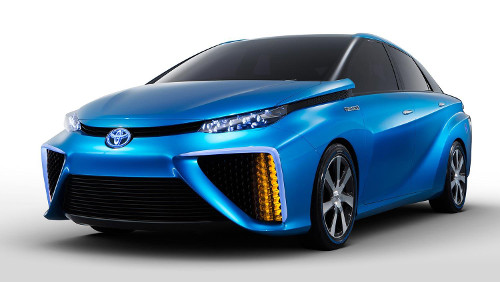
Toyota’s new fuel cell vehicle (FCV) – likely named ‘Mirai’ – may be the car that kills Tesla (At least if Tesla bets too heavily on their own Model III…).
Toyota’s new fuel cell vehicle (FCV) – which shall be known as the “Mirai” – hasn’t even hit the ground yet, and it’s already convincing some stock analysts to advise selling Tesla shares. Here’s why:
- The fuel cell has the investment and backing of all the major automakers. Toyota and Hond have plans to sell FCVs in the short term. GM, VW, Ford, etc. all have plans to develop and sell FCV vehicles this decade. Hyundai is actually selling a fuel cell powered Tucson now.
- It’s high-tech, polarizing, and “green.” If Tesla’s rapid growth as an automotive brand is any sort of blueprint, than Toyota’s FCV needs to be packed with technology, it needs to evoke strong feelings, and it needs to be green. The Mirai hits all three notes.
- It’s backed by one of the world’s largest car companies. This is a tremendous advantage, and it’s the same sort of advantage that the Prius had when it first hit the scene in 1999.
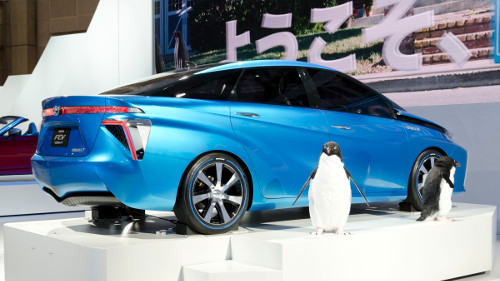
Only Toyota would bring penguins to a car unveil. Still, the point is clear – the Mirai is a clean and green car with a provocative style.
While there are certainly problems with the FCV – not the least of which is the limited availability of hydrogen – there are reasons to be optimistic about FCVs relative to battery electric vehicles. Depending on how optimistic you are about fuel cell technology, you may even see the Toyota FCV as the car that will kill Tesla.
Why FCVs Have Such A Bright Future
Toyota’s $69k asking price for the first gen FCV is often cited as “proof” that fuel cell vehicles are too expensive to be commercially viable. However, fuel cell production costs are expected to drop like a rock in the near term. The DOE guesses that fuel cell costs will fall to as little as $30 per kW of output by 2017. At that price, an FCV with a 120 kW fuel cell will cost about as much as a new Prius.
In fact, by 2020, the Prius may even offer a fuel cell power package, as Toyota is designing their fuel cell powerplants to “drop in” to existing vehicles.
To be sure, there are a lot of problems with FCVs that need to be solved.
- Hydrogen isn’t easy to come by, and while Toyota is working with other automakers to solve that problem by funding new hydrogen station construction, it’s not as if thousands of hydrogen fueling stations are going to “pop up” overnight.
- Hydrogen – especially hydrogen from electrolysis powered by renewable energy – isn’t much cheaper than gasoline, even after accounting for the higher efficiency of the fuel cell.
- Fuel cell production costs are widely expected to fall, but they haven’t fallen yet. The Mirai is going to be a $70k car, after all.
However, when you compare the FCV’s problems to the battery electric vehicle’s problems, things aren’t so bad…
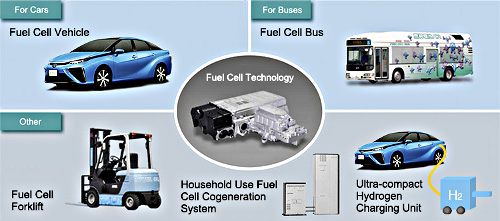
Many people don’t realize that fuel cells can be used in all sorts of vehicles – from buses to fork lifts. In fact, fuel-cell powered fork lifts are starting to sell quite well in warehouses around the world.
Why Battery Electric Cars Are Probably A Dead End
Fundamentally, battery electric vehicles have four problems:
- Battery packs are pricey. A “small” battery pack (like the one found in a new Chevy Volt or Nissan Leaf) is far more expensive to produce than a traditional gas engine.
- Battery packs are heavy. If you’re trying to make an electric car that will travel hundreds of miles between charges, you need to reduce weight. Battery packs, however, are very heavy.
- Battery packs are bulky. Simply stated, it’s hard to design a battery-powered vehicle without a clean sheet design. You can’t just put battery packs where a vehicle’s gas tank and engine would be and call it a day. You need to design the battery pack, then build the car around it.
- Battery performance is highly variable. Temperature, driving habits, and the age of the battery pack itself all determine how far an electric car can go between charges. New Nissan Leaf owners, for example, have reported considerable battery capacity losses after just a few thousand miles of use.
While these problems aren’t “insurmountable,” they’re not easy to solve. The electronics industry has been working on all of these problems for years, and the pace of innovation has been slow. Today’s phones and laptops – for example – have batteries that are only marginally better than those available years ago.
Of course, battery developments are on the horizon…but will they address ALL of the problems above? And will batteries evolve more quickly than fuel cells? It’s hard to say.
Why Tesla Is Flirting With The Danger Zone
Tesla’s success to this point has been nothing short of incredible. They went from a billionaire’s crazy dream in 2008 to a viable global automaker (albeit a niche automaker) by 2014. Tesla enjoys a strong brand name, they make an excellent (albeit expensive) vehicle in the Model S, and they have plans to offer a crossover next year that should grab a lot of sales away from competitors like Porsche, Mercedes-Benz, and BMW.
If Tesla was aiming to be a luxury automaker that sold a limited range of expensive yet capable vehicles, they would be in the home stretch. All they need is a couple more products and they can pop the champagne.
However, Tesla wants to be a mass market company, and that desire could be their ultimate undoing. Tesla’s plan is to unveil a mass-market battery electric car for about $40k sometime in 2015, and perhaps to start selling that car in 2017. This mass-market car (which may be called the Model III) could be Tesla’s Alamo:
- Tesla’s track record of launching products on time is poor. Tesla’s new crossover Model X has been delayed nearly 2 years, the Model S was over a year late, and the Roadster was years late as well. A delay on the Model III could mean the car doesn’t hit the market until 2018 or 2019, which would likely trigger a massive drop in stock value as well as expose the new Model III to increasingly stiff competition.
- To support the Model III, Tesla needs to build a giant battery factory first, as that’s the only way they’re going to hit their “around $40k” price target.
- Tesla needs to figure out how to sell and service vehicles in all 50 states, something that they can’t currently do for a variety of reasons (some beyond Tesla’s control)
- Tesla needs to fend off challenges from BMW’s luxurious (and well reviewed) I8, and Nissan’s increasingly cost effective Leaf (which is due to get more range very soon), and of course FCVs from Toyota, Honda, and Hyunda-Kia.
The last point is key. Musk has all but bet the company on the success of the Model III, and even a short delay could be devastating. Every month that Tesla waits to launch the Model III is another month Toyota, Honda, and Hyundai have to reduce costs of their FCVs and grow infrastructure. Not to mention GM, VW, and others will be offering their own FCVs by that time.
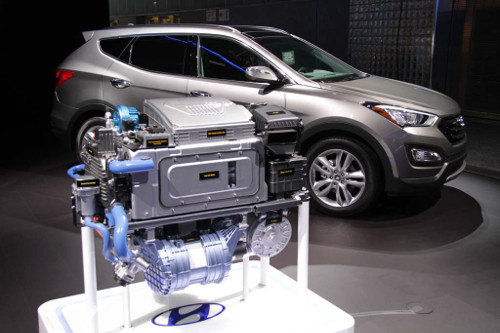
Hyundai’s fuel cell powered Tucson is available for lease in California right now – but Tesla’s Model III is AT LEAST 3 years away. A lot can happen in fuel cell tech between now and then.
Basically, when Tesla finishes their multi-billion dollar gigafactory and actually puts the Model III on the ground, they could be facing very stiff competition from mass-market FCVs backed by the world’s biggest automakers. That’s a scenario that’s almost completely unlike the launch of the Model S, when most of Tesla’s competitors were completely out of the picture.
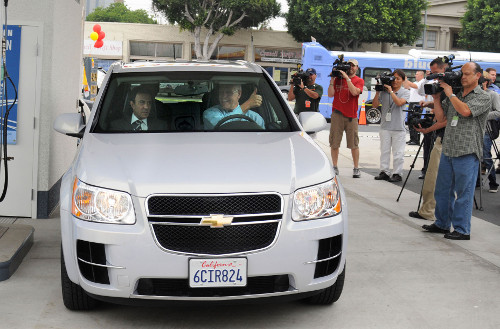
GM is working to offer fuel cell technology in the next few years, as are VW, BMW, Ford, and a slew of others. The FCV market isn’t going to be “crowded,” necessarily, but there are a lot of companies making big investments…and that’s only going to drive down costs.
How You’ll Know When Tesla Is In Trouble
If you’re looking for signs of the Tesla apocalypse, you need look no further than Tesla’s own Elon Musk.
Musk is a genius – I’ve been told first hand by a senior engineer at Space X that Musk himself reviews drawings and plans for rockets, does the same for cars, works 20 hours a day, etc. etc. It stands to reason that Musk understands the technology behind FCVs as well as anyone, and that Musk has a good idea of what FCVs can ultimately become.
Musk is also an incredible marketer. He’s developed a marketplace for his product despite all sorts of high profile failures, from a Roadster that disappointed on the BBC’s test track, to a Model S that ran out of juice during a NY Times review, to numerous reports of Model S vehicles with drive unit failures (including one unit that was being tested by Edmunds.com), to general reports of quality issues.
Which leads us to one question: If Musk knows that FCVs are unworkable, what are the odds he’d publicly mock them? A crafty genius like Musk would probably just ignore FCVs, or make some off-hand comment about them that elicited giggles (like Musk’s comment that fuel cells are “so bullshit” to a crowd of Tesla fans in Germany). After all, there’s no point in talking about a technology that doesn’t compete.
So far, Musk has only gone on record about fuel cells a couple of times – once to call them “so bullshit”, and once to call them “mind-boggingly stupid.” But if Musk continues to make negative comments about hydrogen powered vehicles, well…that will say more about how Tesla views the FCV threat than anything else.
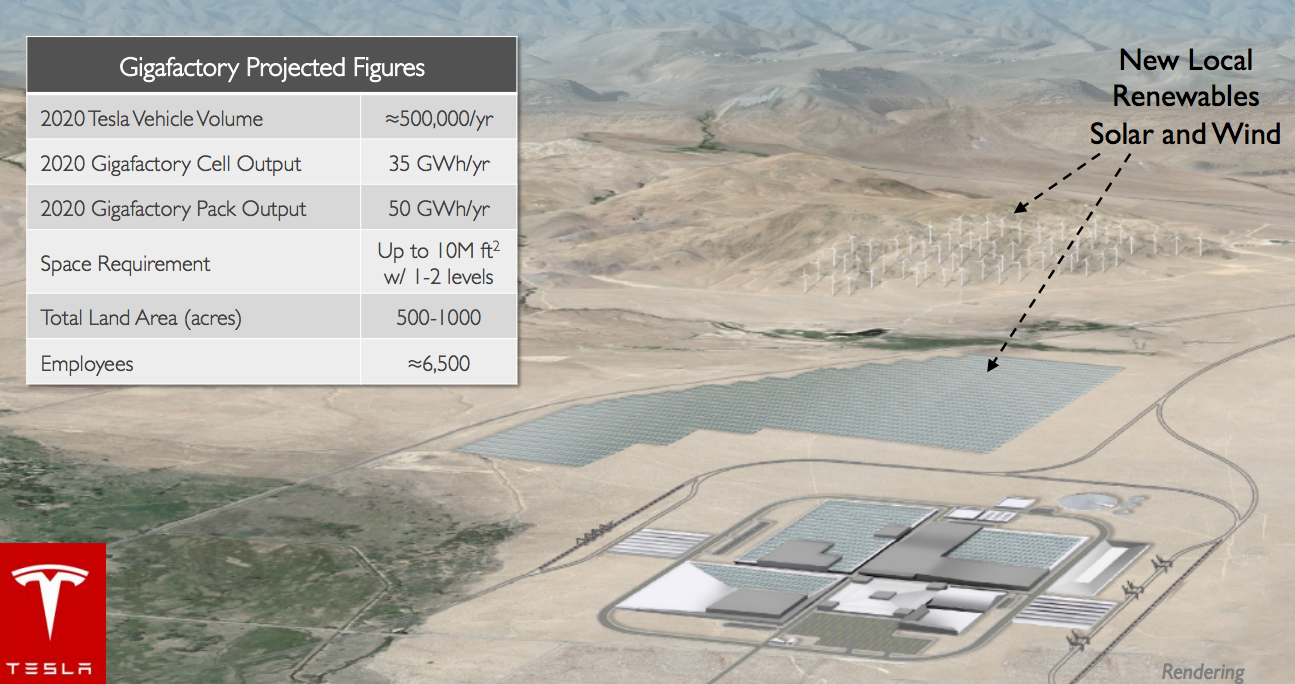
Tesla’s Gigafactory could be the company’s greatest achievement to date, or it could be their Alamo. With a $5 billion price tag, Tesla is counting on the Model III to sell in large volumes. If Tesla can’t deliver the Model III on time – or if competition from FCVs renders the Model III an also-ran – the Gigafactory could be a $5 billion dollar boondoggle.
Personally, I see a future where Tesla survives as a luxury automaker, while Toyota, Honda, VW, GM, and Ford sell the world affordable gas-powered hybrids, diesels, and FCVs. However, if Tesla puts everything on the line when they launch the Model III, they could very well put themselves out of business.
Filed Under: Auto News


The FCV should have place. How we start moving hydrogen around I have no idea. I am currently investing in a natural gas engine maker and natural gas fueling is a problem and it’s years ahead of FCV. What kind of tank will it take to hold atoms that small. We could fill it up and and it 2 days it will all leak out, then what, go to the station with a gas can to get a gallon of liquid H? My rough guess is that it would take 20 years to make it a reasonable option.
As for TESLA. TESLA only makes toys for rich people. Can TESLA make a 30,000 dollar car for real people? Can those real people live with a car they can’t drive to grandma’s house with 3 kinds and the dog at thanksgiving? Is there enough lithium on earth to make enough batteries for 300 million cars in the next 30 years? For those who talk about their TESLA, do they load into the giant Cadillac Escalade when they need real world transport.
I do not know any person who own’s a TESLA. 99 percent of the people I know could not own a TESLA. The would not be able to take that car out a 40 mile dirt road towing a trailer loaded with rafts and cooler etc etc. Do I know any people who could afford a TESLA to play with and a Truck/SUV for real world use. I might know 5 of them. I could afford it but at a price which would eat into my life style which means,,,,,, what would be the point?
The gas or diesel car/truck is going to be the worlds main set of wheels for at least the next 25 years.
Larry – The leaking tank issue is a non-issue. Hydrogen can be contained in a composite tank with almost no leakage – that’s part of the reason why Toyota, Honda, and Hyundai have vehicles now or will start selling them this year.
I do agree that natural gas has promise as a fuel source (only it’s not “clean”, which means it won’t be as attractive to automakers trying to meet carbon reqs), and that gas/diesel will be the primary fuel for at least the next couple of decades.
…but hydrogen is coming. The only question is, how fast will costs drop, how long will infrastructure rollout take place, and can automakers conquer the performance issues?
Forgive my ignorance, but doesn’t fuel cells make electricity?
Could Tesla not swap batteries for fuel cells like the drop-in that can go into a Prius?
Money spent on electric power trains is not wasted on current lithium power if it lends itself to later fuel cell use.
What I would like to see is a big honking electric motor placed between my 5.7L and it’s 6-speed tranny, to reduce my fuel consumption when taking it easy or unloaded and add power when hauling while keeping RPM low pulling a higher gear than I could on gas alone.
This would also extend the limited range of the too small gas tank when fully loaded.
Could be lithium for now, and Toyota could offer a trade in program for old lithium towards a fuel cell upgrade.
I want the electric to have Toyota brains though… no drag when not in use, and serious power when called on – enough to run easy on electric alone in city.
Toyrulz – It’s a great point. Fuel cells could very easily provide electrical power to hybrid vehicles.
However, trucks are particularly suited to run off fuel cells, as the fuel cell stack and storage tank(s) are lighter than a gas or diesel engine, and range issues aren’t nearly as significant as they are for battery electric trucks.
But, to your point, it’s true: battery-powered vehicles and fuel cell vehicles are both electric.
Yes, fuel cells are electrical generators. Electron motion is the source of all electrical power. In a Battery lead/acid or lithium, cadimun and other metals react to cause electrons to move. In a fuel cell electrons are stripped off hydrogen atoms and become free to move.
High pressure hydrogen is stored in a tank and injected into the fuel cell as the source for new electrons. Our problem is that there is no industry in place to distribute liquid or compressed hydrogen. At this point it takes more energy to produce free hydrogen then we get when we use it as fuel. Toyota or any company is only doing this as R&D or public relations. They stand to gained ZERO profit on FCVs in 20 years. They know full well there is no way to fuel these things.
TESLA could replace the battery system with a fuel cell and tank. Buy a fuel cell TESLA and there is no place to fill it up with hydrogen. Musk is smart enough to know this. Electric sources for recharge of battery systems are everywhere.
Fuel cells would make a good electric car but there is a mountain of work which needs to be done to put all the pieces in place. They won’t be an option for years and years.
At this point we only have 2 options, batteries or hybrids. Batteries using heavy metals (because they have the free electrons) lead, nickel, cadmium, lithium are the only options. Lithium is the only element with with enough potential to store enough power to make it work. Cadmium doesn’t work because the chemistry doesn’t last long. These are all nasty metals to deal with. Lithium is rare, there may only be enough for limited use over the next 100 years.
It is my view that the hybrid system is the only real option. The prius and giant GE locomotives are proof it works. A nice modern 4 door tundra with AC and all the good stuff is 40,000 dollars, now add in the cost of a high tech diesel – generator systems and electric motors to drive the wheels and who knows how much it will cost. A Tundra/F150 is not like a GE locomotive which will run 24 hours a day for 30 years. Your suggestion of a motor generator behind the V8 will work for sure but, how much would people be willing to pay for it. I doubt it would yield any better MPG. People (in general) already don’t save any money after they spend 1000 a month for that nice luxury truck. How are they going to pay for all these things?
Research and development is going to bring many new things but only in time frames which might not work for us. Fuel cells have been around for 150 years and in all that time they have not found a practical use for a good reason. I don’t know about everyone else but I figure I will be driving a gas or diesel piston engine truck for however many years I have left.
Larry – I agree that hyrbids are the future for the short term, but I think you’d be surprised my the advances in fuel cell vehicles and related technology.
Home-based hydrogen production systems – which would use solar power to break water down into hydrogen and oxygen, then compress the hydrogen to 5,000 PSI – are technically feasible. Assuming the costs of solar power continue to fall, and assuming a person uses their FCV as a commuting vehicle, it’s feasible to use a home-based system for refueling at a cost that’s quite similar to buying electricity off the grid.
There are lots of reasons to be pessimistic, but I’d encourage you and any other pessimists to consider the following: photovoltaic solar cell costs are falling fast. When they can produce electricity for $0.03 per kW, it will be 100% economic to use that electricity to break water down into hydrogen and oxygen. At that point, the “it takes more energy to create hydrogen than we get from it” argument becomes irrelevant, as energy will be so cheap it wasting it won’t be a concern.
Cheap solar or cheap wind + water = cheap hydrogen. THATs what Toyota (and all the other automakers pursuing FCVs) see down the road.
Good point but you ignore a big issue. Photovoltaics may be abel to get down to .03 per kw. How much electrical power does it take to drive a compressor that will deliver 5000 PSI? A home air compressor can use 10 amps at 120 to develop 150 PSI. It would take more solar panels to run the compressor then we could fit on 95 percent of the private properties people own.
People need to dig in and know all the costs and issues.
At this point fuel cells are only good for space travel because the only entity which can use them has the power to print money.
A natural gas filling station which can fast fill 4000 PSI to 4 pumps is over 1 million dollars. It requires 1 mega watt of power and a 6 inch gas line to the station. Liquid hydrogen trucks at -420 degrees? Nat Gas at -260 is difficult enough to deal with. All this is part of why I am losing money on my Nat Gas engine investments. There was a lot more to the picture then just the price of the NAT gas. There is at this time no way to move around the required amounts of hydrogen.
Now, gas pipes are already in place. Hydrogen refilling infrastructure does not exist at all. Hydrogen fuel cells are only a dream at this point. Nat Gas as the hydrogen source might have a better chance.
Larry – Even if hydrogen costs more to produce than just storing grid power in a battery, the fuel cell stacks are going to be cheaper than big battery packs (believe it or don’t), and you can refuel an FCV in a few minutes.
I don’t know what the future will hold, but Toyota isn’t a company known for making strategic mistakes, nor are they cavalier. If Toyota thinks FCVs have potential, that in and of itself ought to be reason to give them serious consideration. 🙂
Technological advancements are a beautiful thing, but there is a interesting thing to note in this particular case. I don’t drink gasoline. I don’t eat coal. Nuclear power sources are certainly not edible.
With the inclusion of ethanol in fuels, the price of corn has skyrocketed. What of water? Hydrogen is obtained by a number of means to which I certainly have no expertise or professional understanding. I suspect H2O (water) would be used in the process to extract hydrogen. At this point, I suspect the thought process of most would lead thinking into the assumption that water is an unlimited resource. What if humans, animals, and plants had to compete with its use for a means to fuel a worlds transportation needs?
One would think hydrogen is potentially an unlimited and possibly a regenerative resource but will this technology turn it into a commodity? As members of the food chain, we have never had competition between a means for transportation and a life source. We live in interesting times.
The problem with converting H20 is that it takes at least twice as much energy to convert H20 into hydrogen as the fuel cell can recover from the hydrogen.
GM had a plant near here for 10 years working exclusively on fuel cell systems and FCVs. 2 years ago they closed the plant, scrapped the project, and left town.
mendonsy – It’s true – breaking water down into components is a net energy loser. However, I’m not sure that’s a big deal.
In my mind, hydrogen fits in as a grid storage tool AND as a fully renewable fuel source. Currently, the problem with wind and solar power isn’t cost so much as it is load balancing…utilities can’t assume that solar and wind can provide all the power we need all day long, so they can’t convert their entire system to wind and solar.
However, if utilities invested big in wind and solar, they could store any “excess” electricity in hydrogen, then either a) sell that hydrogen to the public for use in their vehicles or b) develop grid-sized fuel cell power stations.
If we had an energy system that used wind and solar for power generation, and hydrogen (created via electrolysis) for energy storage, we’d be 100% renewable. No more pollution, no more drilling holes in the ground and running pipelines.
Of course, a lot of smart people say that hydrogen is a bad idea…so it may be that Tesla kills the FCV, rather than the other way around.
The loss of energy from the process of electrolysis to extract the hydrogen is only part of the problem. Next, energy must be expended to compress the gas into tanks or the energy losses to liquify it down to -425F to store it. Then it needs to be vented to maintain that liquid state. LNG is difficult enough to manage, liquid hydrogen is not going to be a commodity for distribution. That leaves us with hydrogen pipe lines of which there are none.
People will go nuts if it is suggested that more fossil be used to split H20. Nuclear power could do it and not create any CO2 but, people don’t like that option either not to mention the cost of a modern reactor. Wind farms and solar farms? Try to put that next to someones property. I have had to deal with people who did not want wind turbines in their line of sight. “Not on any mountain side in my line of sight”
Add all the items up and it’s very unlikely that hydrogen will ever be a cost effective fuel for anything other then a cutting torch.
Hydrogen fule is a dream which will only work when the problem of Fusion reactors have been solved. That will be the only unlimited electrical power source which could make electrical power available to get the free hydrogen. That’s not even close to a possibility in 75 years and that’s being optimistic.
As for the issue of electrolysis consume the water we need, that’s not an issue. We can’t drink sea water anyway. In addition each home uses 100s of times more water then fuel conversion would require.
Larry – Distributing hydrogen via a network of pipelines doesn’t make sense, nor does liquefying it.
The future is in producing electricity locally, converting cheap wind or solar into hydrogen at the point of sale. There are a few local production fueling facilities in operation across the USA, and this is the model that Toyota and Honda are emphasizing.
As I said in a previous comment, home-based production systems are the real future. Not only can they produce hydrogen to fuel a vehicle, but they can also produce hydrogen to power a home when wind/solar aren’t available.
http://world.honda.com/FuelCel.....enStation/
These systems won’t be cheap in the short term, but fuel cell stack (and electrolysis system) cost reductions could make a home-based hydrogen production system about as expensive as an in-ground swimming pool at some point.
Personally, I see hydrogen being the ideal storage medium for excess solar and wind.
John – An interesting idea to be sure. Demand for ethanol absolutely drove up corn prices, and that did cause some problems for food aid programs (at least according to some).
If/when demand for water becomes so great that it comes down to using it for fuel or using it to drink, we’ll have a problem…but there are reasons to believe that alternatives (like large-scale desalinization) might address that issue.
Also, the most common way to create hydrogen today is to steam reform natural gas…so in the short term (until electrolysis becomes commercially viable), we’ll be using natural gas to make most of the hydrogen for FCVs.
Good point Jason,
Natural gas and it’s current supply make it a much better source of hydrogen then getting it from H2O.
2H2O —> 2H2 + O2
When H2 is used, it combines with O2 from the atmosphere, and you get H2O once again – water.
You don’t use up the water, and these amounts are very small so not really an issue.
You need 8.9 litres water to produce 1kg hydrogen.
(You will be able to drive a car aprox. 100km on 1kg hydrogen.)
Hydrogen wont be stored in huge volumes, but rather produced when it is needed. So it wont “tie up” huge volumes of water.
http://www.answers.com/Q/How_m.....ctrolysis#
My car needs, 150km a day, would “tie up” a couple of buckets of water.
But that said.. I’d rather use the electricity direct in my car via a battery, than having to pay double to transform it from electrons to H” and back to electrons.
I really don’t see the logic in this.
runar – Respectfully, “logic” has nothing to do with transportation choices. What matters is cost and convenience. If cheap renewable power is available, who cares if we waste it? Filling up an FCV with hydrogen is fast and convenient, and as long as these vehicles are comparable to gasoline, consumers won’t have much trouble with it.
To use an old truism: If it makes dollars, it makes sense.